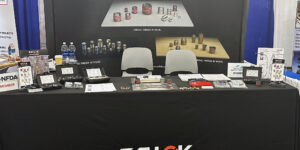TURNING POINT: FIT AND FORGET
Sliding slewing ring bearings are a low-cost replacement for expensive roller bearings, but Tom Miller of igus explains why the environment, loads, speeds and rpm, and other parameters must be considered before selecting the right type of bearing for your application.
Posted: June 29, 2010
If you?ve ever been in the market for a slewing ring bearing, you may have found the number of available options to be somewhat limited. Roller slewing rings have been the only choice for rotating or turntable applications, but for your next project you might want to consider a new technology: sliding-element slewing ring bearings.
Sliding slewing ring bearings can be considered a middle-ground solution. While they don?t offer the same level of precision or load capacity that a rolling element does, sliding slewing ring bearings do offer a high-performance, lower-cost alternative. I would also estimate that seven out of every 10 people using high-priced rolling elements chose them simply because they believed they were the only option available, not because the application required them.
Most roller bearing designs use metal, stainless steel or ceramic balls to maintain the separation between the moving parts of the bearing. In contrast, sliding slewing ring bearings use self-lubricating, low-friction polymer sliding elements in place of balls (see Figure 1). Where roller bearings require constant lubrication and regular maintenance, sliding slewing ring bearings are a ?fit-and-forget? solution, as they do not require any additional lubrication or scheduled maintenance. Thanks to their lubrication-free properties, they won?t contaminate environments or seize in applications with dirt or dust, unlike roller bearings.
The plastic sliding elements and hard anodized-aluminum finish of sliding slewing ring bearings possess low moisture absorption and corrosion-resistance and so do not require a cover or seal around the slewing ring when used in wash-down applications (see Figure 2). Sliding slewing ring bearings can also be used in medical and lab equipment, solar panels, food processing and packaging machines and many more.
PERFORMANCE FACTORS
? Load Capacity ? Sliding slewing rings can now handle dynamic loads up to 20,000 lb in the axial direction and dynamic radial loads up to 6,000 lb, which makes them ideal for applications with low to moderate loads. Roller bearings are best for applications handling exceptionally high loads.
? Speed and Rotation ? Sliding slewing ring bearings operate at a maximum of 200 rpm, while a rolling system can deliver up to 500 rpm. Clearly this is a large difference, but for the majority of applications, a sliding slewing ring can easily handle the job. On the rare occasion that an extremely high number of rpm are required, a roller bearing would be the better solution. They are the best choice for fast, continuous rotations; while sliding slewing rings are ideal for applications with inconsistent movement at slow to moderate speeds or for fast speeds with very low loads.
? Vibration Absorption ? Sliding slewing ring bearings have excellent vibration-dampening ability. When tested, PRT slewing ring bearings outperformed roller bearings in atmospheric conditions at 5G. The vibration caused the balls in the roller bearing to fly out, while the sliding slewing bearing absorbed the vibration and remained completely intact.
? Temperature ? Both roller bearings and sliding slewing ring bearings can be used in extreme temperatures. The difference is sliding systems (with the plastic elements and optional stainless rings) can be used in applications reaching 392 deg F and the maximum temperature that a roller bearing can endure is determined by the particular metals it is made of.
? Price ? Choosing products that deliver a superior performance is a priority, but cost is also an important consideration when deciding on any component. Sliding slewing rings offer superior quality in comparison to turntable-style slewing rings, but cost a lot less than high-end roller bearings, which are not necessary for many applications.
CASE STUDY: ULTRASONIC WELDING
For example, consider the rotary motion on an ultrasonic welding machine. A developer and manufacturer of custom-made equipment for the fabricating industry uses sliding slewing ring bearings for rotary motion on an ultrasonic welding machine. PRT slewing ring bearings facilitate movement on both the X and Y axis of the machine, which enables the welding gun to achieve numerous degrees of freedom and perform a variety of different welding jobs (see Figure 3). The slewing ring bearings replaced a system of metal shafts and flange bearings that required time-consuming assembly and maintenance.
The PRT slewing ring bearings do not require lubrication and so are unaffected by the welding dust produced by the machine and will not seize, unlike other bearing systems can (see Figure 4). The unit comes as a ready-to-install solution, so the manufacturer saves both time and money during the design and assembly process. The PRT range uses low-friction polymer sliding elements in place of ball bearings. These sliding elements are made from a low-cost, high-performance polymer called iglide J, which is completely lubrication- and maintenance-free. PRT slewing ring bearings are suitable for all environments; in particular, semiconductor and cleanroom applications, assembly lines, production facilities and robots.
PRT slewing ring bearings are an off-the-shelf, low-cost solution. All the housing components are made from aluminum (except style 02, which uses wear-resistant iglide J head rings) and all the surfaces parallel to the iglide J sliding elements are hard anodized with stainless steel fasteners. Stainless steel and geared versions are also available with inside diameters of 30, 60, 100, 150, 200 and 300 mm.
CONCLUSION
Sliding slewing ring bearings are a low-cost, replacement for expensive roller bearings. However, always consider all the parameters, such as environment, loads, speeds and rpm, before recommending the right type of bearing for your application.
—————————————————————————
Tom Miller is the bearing business unit manager for igus Inc., PO Box 14349, East Providence, RI 02914, 401-438-2200, Fax: 401-438-7270, www.igus.com. Tom is interested in your thoughts about sliding slewing ring bearings verses other bearing designs. Contact him at tmiller@igus.com.









